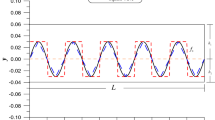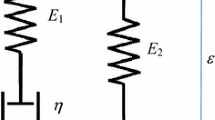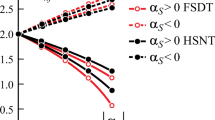Abstract
The application of Kantorovich's method to a trinomial model of deformation taking into account transverse bending of a plate leads to a connected system of three ordinary differential equations of fourth order with respect to three unknown functions of the longitudinal coordinate and to the coresponding boundary conditions for them at the fixed end and on the free edge. For the approximate calculation of the frequencies and forms of natural vibrations Galerkin's method is used, and as coordinate functions we chose orthogonal Jacobi polynomials with weight function. The dimensionless frequencies depend on the magnitude of the four dimensionless complexes, three of which characterize the anisotropy of the elastic properties of the composite. For the fibrous composites used at present we determined the possible range of change of the dimensionless complexes d16 and d26 attained by oblique placement. The article examines the influence of the angle of reinforcement on some first dimensionless frequencies of a plate made of unidirectional carbon reinforced plastic. It also analyzes the asymptotics of the frequencies when the length of the plate is increased, and it shows that for strongly anisotropic material with the structure [ϕ]T the frequencies of the flexural as well as of the torsional vibrations may be substantially lower when flexural-torsional interaction is taken into account.
Similar content being viewed by others
References
E. P. Crawley and J. Dugundji, “Frequency determination and nondimensionalization for composite cantilever plates,” J. Sound Vibration,72, No. 1, 1–10 (1980).
G. A. Oyibo and J. Bentson, “Exact solutions to the oscillations of composite aircraft wings with warping constraint and elastic coupling,” AIAA J.,28, No. 6, 1075–1081 (1990).
T. A. Willway and R. G. White, “The effectsof matrix complex moduli on the dynamic properties of CFRP laminae,” Composite Sci. Technology,36, No. 1, 77–94 (1989).
V. S. Ekel'chik and V. M. Ryabov, “Various methods of determining the natural frequencies and damping of composite cantilever plates. I. Exact solution for the binomial model of deformation,” Mekh. Kompoz. Mater.,32, No. 6, 759–769 (1996).
D. W. Jensen and E. P. Crawley, “Frequency determination techniques for cantilevered plates with bending-torsion coupling,” Amer. Institute of Aeronautics and Astronautics J.,22, No. 3, 415–420 (1984).
J. T. Mottram, “Flexural testing of general multilayered composites,” J. Composite Materials,25, 1108–1126 (1991).
K. Chandrashekhara and K. M. Bangera, “Vibration of symmetrically laminated clamped-free beam with a mass at the free end,” J. Sound Vibration,160, No. 1, 93–101 (1993).
E. Reissner and M. Stein, Torsion and Transverse Bending of Cantilever Plates, NACA TN 2369 (1951).
J. M. Whitney, C. E. Browning, and A. Mair, “Analysis of the flexure test for a laminated composite materials,” in: Composite Materials: Testing and Design (3rd Conf.), ASTM STP 546, ASTM (1974), pp. 30–45.
I. G. Ritchie, H. E. Rosinger, and W. H. Fleury, “The dyanamic elastic behavior of a fiber-reinforced composite sheet. II. The transfer matrix calculation of the resonant frequencies and vibration shapes,” J. Phys. D: Appl. Phys.8, No. 15, 1750–1768 (1975).
V. S. Ekel'chik, V. M. Ryabov, and B. A. Yartsev, “Coupled bending-torsional vibrations of anisotropic rods made of polymer composite materials. 1. Theoretical analysis of the influence of the parameters of the material and of the geometry of a rod on the natural frequencies, “Mekh. Kompoz. Mater.,No. 6, 998–1004 (1991).
Additional information
For Communication 1 see [4].
Institute of Engineering Science of the Russian Academy of Sciences, St. Petersburg, Russia. St. Petersburg State University, Russia. Translated from Mekhanika Kompozitnykh Materialov, No. 1. pp. 23–33, January–February, 1997.
Rights and permissions
About this article
Cite this article
Ekel'chik, V.S., Ryabov, V.M. Various methods of determining the natural frequencies and damping of composite cantilever plates. 2. Approximate solution by Galerkin's method for the trinomial model of damping. Mech Compos Mater 33, 15–22 (1997). https://doi.org/10.1007/BF02274246
Received:
Issue Date:
DOI: https://doi.org/10.1007/BF02274246




